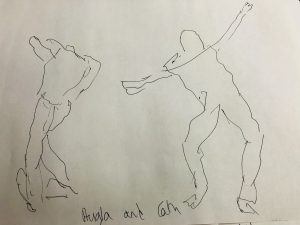Drawing and painting in time
Though I have used oil for quick sketches outdoors, on primed or unprimed paper, in my studio paintings on canvas I take a more traditional, slower approach. Putting layer upon layer, or glaze upon glaze, as I let the painting emerge in a sort of dance between my hands, eyes, memory, the medium, and the time available. Then waiting for it to dry! This is why I usually have two or more paintings on the go at the same time, so when one needs to try, I turn to another. I love this slow discovery and building of the final image that can last over months.
I always say that my eureka moment of realising how oil paints worked was when a student at the Ecole des Beaux Arts, in Paris, and looking at some moss in a field; the plant that gave life its first breath more than 400 million years ago. I’ve always felt a sort of private reverence for the magical, spiritual qualities of moss, associating it in woodland contexts with the fairies I was told danced there in my childhood. But, on this day, as I looked at the different colours whose layers constituted the ‘green’ colour we associate with moss – the peaty umber of the soil, the burnt sienna of the roots, the darker green of the lower leaves and the range of reds of the spore capsules topping the stalks, this radically changed my understanding of how to produce colour on a canvas. It was not just a question of mixing different pigments, but of layering. I tend to use a lot of green in my paintings, so this was useful!
When drawing though, that’s a different ball game. Fast is good – freeing up the movement of the hand and arm movement, and not really looking at what you’re drawing until you stop. When the Butoh group I work with were doing some warm up exercises and improvisation last weekend, I stepped outside of the dance for a moment to draw it instead. When drawing moving bodies I do not try to reproduce recognisable body shapes, but just use line and form to capture something of the movement. It’s very freeing not to think each ‘body’ should have two legs, two arms, a head etc. but just be lines and forms of movement in time and space. The odd thing is, that you when you stop and look at the drawings, you can actually recognise the different dancers.



Comments are closed.